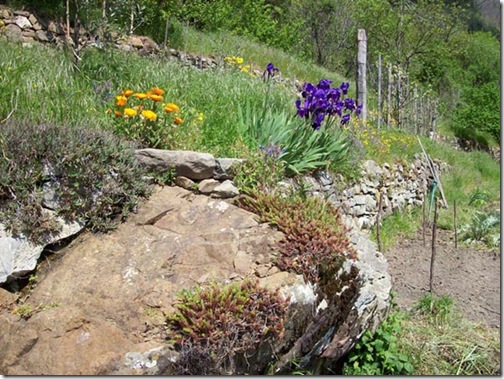After months of living in an almost monochromatic winter world, the tapestry of colors that nature has woven around us is almost overwhelming. Living, as we do, in the virtually unspoiled landscape of Lunigiana it is always such a joy and privilege to witness la rinascita della natura dopo il suo lungo riposo (the rebirth of nature after her long rest).
This year, due to other commitments, we’ve decided to scale down our orto (vegetable patch), and limit ourselves to cultivating a few easy things such as pomodori (tomatoes), melanzane (aubergines/eggplants), zucchine (courgettes), e così via (and so on). Of our three terrazze (terraces) only one will be cultivated, the other two will be more or less left to do their own thing. One big advantage of this so far has been that we do all the hard work of digging amidst a wonderland of wildflowers, quanti bei fiori! (so many beautiful flowers!).
Ecco una foto di un angolino del nostro terreno (here’s a photo of a little corner of our land). In questa foto si possono vedere (in this photo you can see):

| In primo piano sulla roccia c’è il risetto, cioè una varietà di sedum |
In the foreground on the rock there is ‘risetto’, which is a variety of sedum. |
| sopra la roccia quei fiori arancioni brillanti sono le calendule |
above the rock, those bright orange flowers are calendula, which are a type of marigold |
| i piccoli fiori azzurri accanto al risetto sono la borragine, le cui foglie sono buonissime da mangiare una volta cotte |
the little blue flowers next to the sedum are borage, the leaves of which are really good to eat when cooked |
| i grandi fiori viola con le foglie a forma di lancia si chiamano iris, che da noi crescono spontanei |
the big purple flowers with the spear like leaves are irises, which grow wild where we live |
| quel mare di giallo che si vede sullo sfondo sono i denti di leone e i ranuncoli, detti anche botton d’oro, che in questo periodo fioriscono dovunque |
that sea of yellow flowers which you see in the background are dandelions (literally: lions teeth) and buttercups, also known as ‘golden buttons’, which are flowering everywhere at the moment |
| le piante che si arrampicano sulla fila di pali sono le viti, che stanno appena buttando le prime foglie |
the plants climbing up the line of poles are grapevines, which are just putting out their first leaves |
| il tutto è circondato da una marea di erba ed alberi tipo frassini, noccioli, prugni, fichi, ciliegi, ecc. |
all of these are surrounded by a mass (literally: a tide) of grass and trees, such as ash, hazel, plum, fig, cherry etc. |


Comments:
Carolina:
Che bel pezzo di giardino Serena! Mi piace il fatto che gli iris crescono spontanei. Non lo fanno qui. Li amo perche vengono in una marea dei bei vividi colori.
Grazie per la foto. Tengo molto lavorare in giardino.
Vince Mooney:
Salve Serena:
In the US we are very concerned with rotating crops. We would plant clover if we were not going to put in a crop. Your land may have been cultivated for over 2000 years. What do you do to replenish the nutrients in the soil? Do you just let it grow wild?
Vince
serena:
@Vince Mooney Ciao Vince,
Toscana is famous for its rotating crops, they’re called girasoli (sunflowers, or literally “rotate with the sun”, ha ha!).
Seriously though, it’s quite common here to plant ‘Erba Medica’, which, I believe, is a variety of clover. This is used mainly as animal fodder, and ‘le bestie’ (beasts/livestock) produce ‘il letame’ (manure) to ‘concimare’ (fertilize) the soil. In the past, everyone in these little village kept cows, donkeys, chickens, goats, and so on, and hence there was no shortage of ‘letame’. These days, there is less livestock in the villages (meno male!) so we buy sacks of prepared ‘concime di stallatico’ (fertilizer from the stables, i.e. horse and cow dung). Also, as most of us heat our houses with wood fires, we spread ‘la cenere’ (the ash) on the orto because it is an excellent concime.
Letting the orto go wild is a result of either lack of time or ‘la pigrizia’!
Saluti da Serena
Vince Mooney:
Salve Serena:
I think it is sad about not having the animals as you once did. They had plenty of animals in the sixties in the Udine area (which looks just like your photos of your area).
Your nose would always tell you when the farmers were fertilizing their fields. You can use animal fertilizer forever but I’m not sure you can use artificial chemicals without eventually depleting the fields.
I always love to see your pictures. Your posts are always interesting because you will write about anything. By going to your posts every day,(and the W’word of the Day’), I’m keeping the Italian I used to know and perhaps even building it. Thanks.
Vince
andreas:
Salve Serena!
Che bel giardino avete!
Ma io ho come sempre una domanda linguistica: ti piacciono le forme piu’ latine come calendula, ranunculo, perche’ il mio dizzionario Zanicchelli da calendola, ranuncolo.
Andreas
serena:
@andreas Salve Andreas!
Allora, “calendola” è anche scritta “calendula” (dal latino) e a me piace di più chiamarla calendula, mentre ranuncolo è stato un mio sbaglio, perché il fiore è “ranuncolo”, ma la famiglia è quella della “ranunculacee”: mamma mia che confusione. Grazie per il tuo commento linguistico sempre molto preciso.
Saluti da Serena
andreas:
Salve Serena!
Grazie per la risposta.
Ma la famiglia si chiama nel latino ‘ranunculaceae’.
Anche a me piacciono molto le piante, ma piuttosto le piante tropicali. Ma ho in casa mia qualche pianta che crescono fuori da voi, come un mirto e Adiantum capilla-veneris, anche due edere differenti. Volevo diventare biologo, ma sono diventato filologo.
Andreas